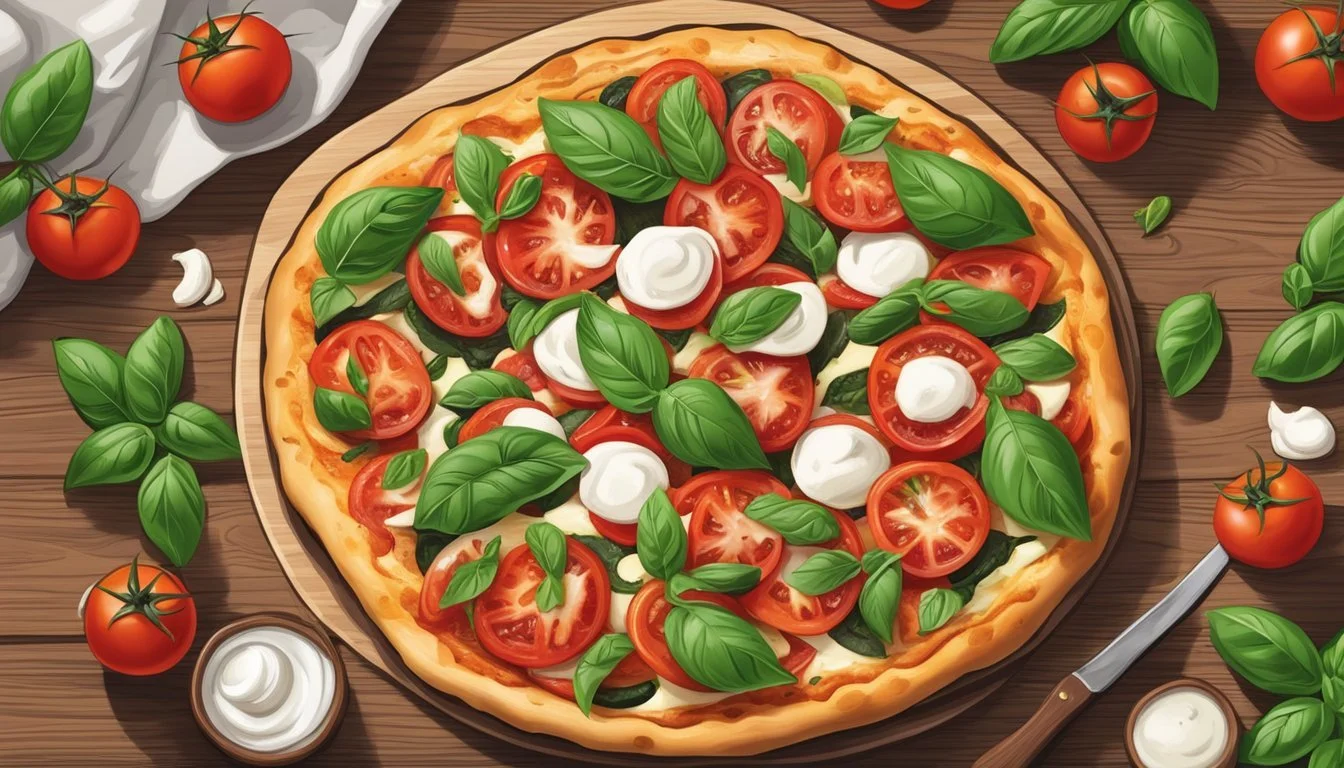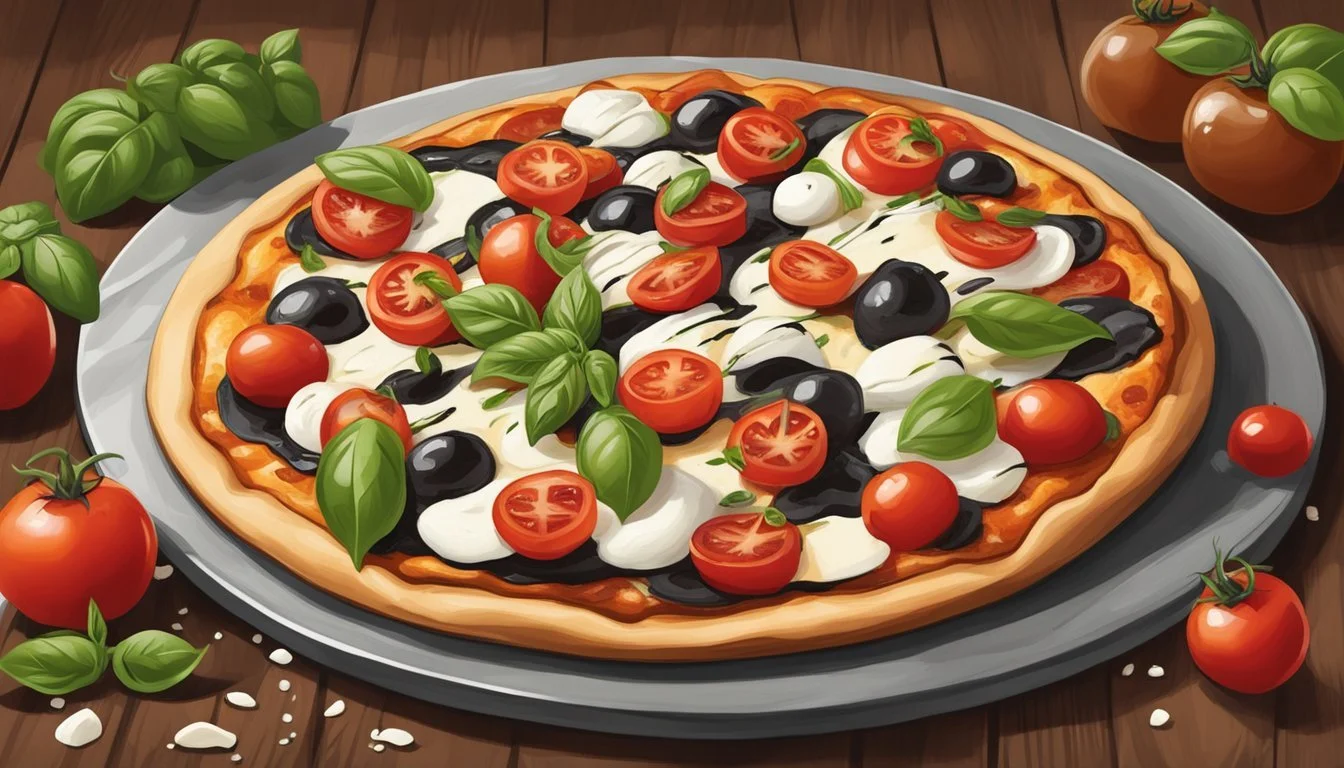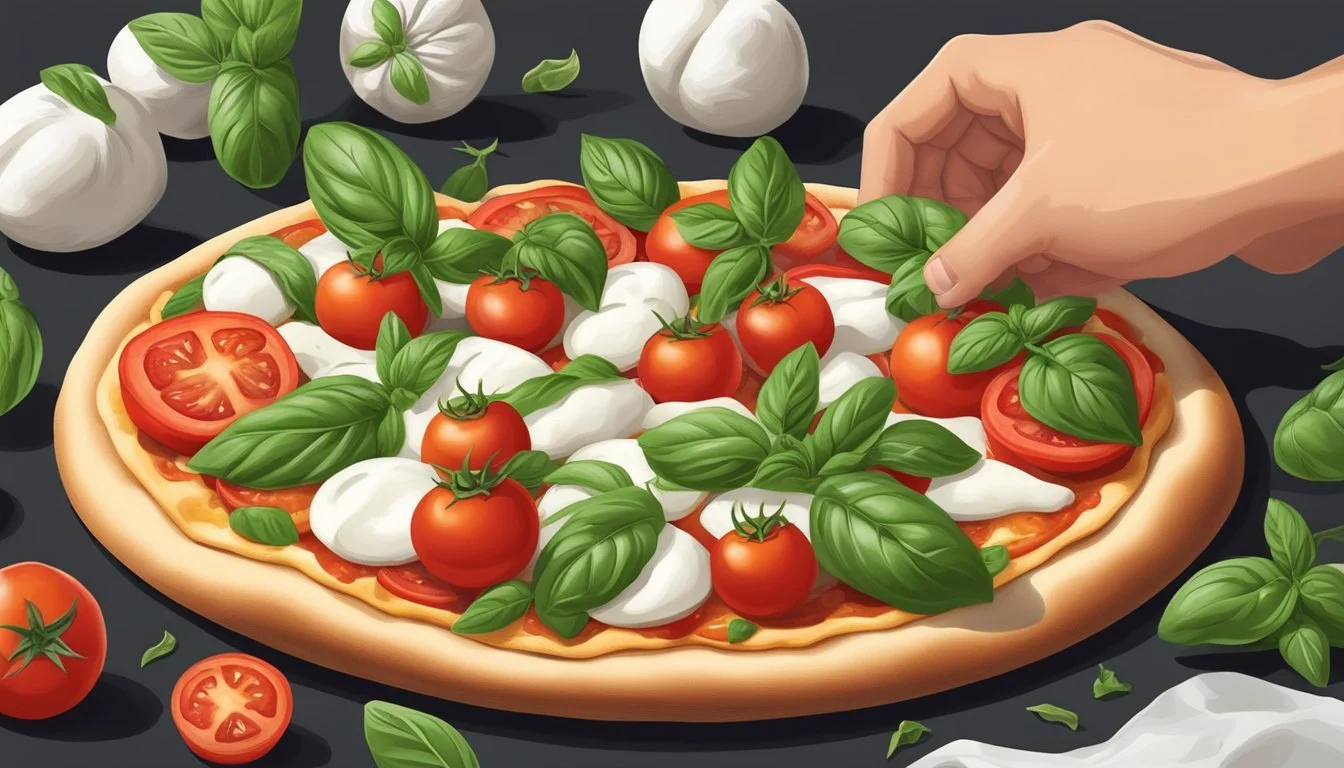How Long Does Caprese Pizza Last?
Shelf Life and Storage Tips
When thinking about a delightful Caprese pizza, it's essential to consider how long this tasty dish can remain fresh and safe to eat. Caprese pizza typically lasts up to 3-4 days when stored properly in the refrigerator. This timeframe ensures the best taste and quality, maintaining the vibrant flavors of the tomatoes, mozzarella, and fresh basil that make it so special.
Pizza night is often a cherished event for families, providing an opportunity to savor delicious homemade recipes together. A well-prepared Caprese pizza can be a family-friendly option, catering to both adults and kids alike with its simple yet flavorful combination of ingredients. Storing leftovers correctly ensures that the enjoyment doesn't have to end when dinner is over.
To prolong the freshness of your Caprese pizza, it's crucial to store the slices in an airtight container and refrigerate promptly. This practice helps maintain the pizza's integrity, so you can relish its rich taste even a few days after serving. Whether you're planning a family pizza night or need a quick and delightful meal during the week, knowing how to store your Caprese pizza is key to maximizing its lifespan.
The Essentials of Caprese Pizza
Caprese pizza is a delightful and simple dish rooted in Italian tradition. It combines ingredients like fresh mozzarella, fresh basil, and tomatoes, offering a taste of summer in every bite.
Characteristics of Caprese Pizza
Caprese pizza is known for its minimalistic approach. It uses fresh mozzarella, which melts beautifully, creating a creamy texture. The tomatoes are often roasted or sliced fresh, adding a vibrant flavor.
Fresh basil is added after baking, ensuring the leaves stay crisp and aromatic. Olive oil is drizzled over the top, enhancing the flavors.
In some recipes, a balsamic glaze is used to add a tangy sweetness. This combination of ingredients reflects the simple yet rich culinary style of Italy.
Preparing Your Pizza Base
Creating the perfect pizza base involves careful selection of ingredients, mastering dough-making techniques, and using tools like a pizza stone for an ideal crust. Each step is crucial for a delicious result.
Choosing the Right Flour
Choosing the right flour is paramount for a quality pizza crust. Bread flour is a popular choice due to its high gluten content, which provides a chewy texture. For a lighter crust, all-purpose flour works well. Gluten-free options are available for those with dietary restrictions, typically made from a blend of rice flour, cornmeal, and tapioca starch.
Using high-quality flour ensures better fermentation and elasticity. Look for flours labeled "00" for a traditional, Italian-style pizza, known for its fine grind and ability to stretch into paper-thin layers without tearing.
Homemade Pizza Dough Making Tips
When making homemade pizza dough, combining flour, water, yeast, and salt in the correct proportions is essential. Knead the dough until smooth and springy; this develops the gluten network needed for a good rise.
Letting the dough rise adequately, preferably overnight in the refrigerator, enhances the flavor and texture. Ensure the dough rests at room temperature for 30 minutes before stretching it to make it easier to work with.
Using a Pizza Stone for the Perfect Crust
A pizza stone is key for achieving a crispy crust. Preheat the stone in the oven at 450ºF for at least 30 minutes before baking. This high heat mimics traditional brick ovens, resulting in a well-cooked base.
Place the pizza dough atop parchment paper or dust a pizza peel with semolina flour to prevent sticking. Transfer the dough onto the hot stone swiftly to retain as much heat as possible. This step ensures a crispy, golden crust while the toppings cook evenly.
Selecting High-Quality Ingredients
Using high-quality ingredients is essential for making a delicious Caprese pizza. Key components such as fresh basil, ripe tomatoes, and creamy mozzarella enhance the overall flavor and texture of the dish.
The Importance of Fresh Ingredients
Fresh ingredients are vital for Caprese pizza. They provide vibrant flavors and textures that make the dish exceptional.
Fresh basil adds a fragrant aroma and a distinct taste.
Ripe tomatoes, whether cherry or heirloom, offer a juicy and sweet profile, and creamy mozzarella ensures a rich, smooth texture. Using stale or low-quality ingredients can result in a subpar pizza experience.
Varieties of Tomatoes and Basil
Choosing the right tomatoes and basil can significantly impact the taste of your Caprese pizza.
Cherry tomatoes are small, sweet, and burst with flavor, making them a popular choice.
Heirloom tomatoes offer a variety of shapes, colors, and rich, savory flavors.
For basil, Genovese basil is commonly used due to its sweet and slightly peppery taste. Ensure the tomatoes are ripe and firm, and the basil leaves are fresh and aromatic.
Choosing the Best Mozzarella
Selecting the best mozzarella is crucial for the perfect Caprese pizza.
Fresh mozzarella is preferred for its soft texture and mild, creamy flavor.
Look for mozzarella that is stored in brine; this ensures it remains moist and flavorful. Buffalo mozzarella offers a richer taste and is an excellent alternative if available.
Avoid pre-shredded mozzarella, as it often contains additives that prevent proper melting and can alter the natural taste.
Assembling and Cooking Your Pizza
Creating a mouthwatering Caprese pizza begins with thoughtful layer placement and precise cooking. Using fresh ingredients is key to achieving its signature flavors.
Layering for Flavor
Start with a homemade pizza crust or a premade one if you're short on time. First, spread a thin layer of olive oil over the crust to act as the base; this can be mixed with pesto for additional zest.
Next, arrange the sliced tomatoes evenly across the surface, ensuring they cover most of the crust. Layer fresh mozzarella cheese slices over the tomatoes, allowing for some overlap to ensure even melting.
Sprinkle with salt and pepper to enhance the natural flavors. Finally, add fresh basil leaves as the pizza comes out of the oven to keep their vibrant flavor and color.
Bake the pizza at 450°F for 12-15 minutes, or until the cheese melts and the crust turns golden brown. Drizzle with balsamic reduction before serving for that classic Caprese finish. This combination ensures a flavorful and visually appealing vegetarian dish perfect for a weeknight dinner.
Enhancing Your Caprese Pizza
Creating a Caprese pizza at home opens up numerous possibilities for customization. Enhancements like homemade pesto, additional toppings, and special drizzles can elevate your dish significantly.
Homemade Pesto Variations
Homemade pesto provides a fresh and flavorful addition to Caprese pizza. Basil pesto is a popular choice, made with fresh basil, garlic, pine nuts, Parmesan cheese, and extra virgin olive oil.
To vary the flavor, consider using different greens. Arugula pesto offers a peppery twist, while kale pesto provides a more robust taste. For those with nut allergies, sunflower seeds or pumpkin seeds can replace pine nuts without compromising on flavor.
Spread a thin layer of pesto over the pizza before adding other toppings to infuse each bite with aromatic herb goodness.
Adding Complementary Toppings
While the classic Caprese pizza keeps it simple with mozzarella, tomatoes, and basil, adding a few more toppings can enhance the taste and texture.
Olives add a briny contrast, while prosciutto introduces a savory, salty element. For a vegetarian twist, sautéed mushrooms or red onions can add depth. Fresh arugula sprinkled on top after baking provides a peppery finish and a crisp texture.
When adding extra toppings, balance is key. Avoid overloading the pizza to maintain the integrity of the crust and the harmony of flavors.
Drizzling Oils and Vinegars
Drizzling high-quality oils and vinegars over Caprese pizza can make a significant impact. Extra virgin olive oil is a staple. Its rich, fruity profile enhances the natural flavors of the tomatoes and cheese.
For an added touch, consider a drizzle of balsamic vinegar. Aged balsamic offers a sweet and tangy complement to the creamy mozzarella and fresh basil.
Experiment with infused oils, such as garlic or chili oil, for added complexity. Apply these drizzles sparingly to avoid overpowering the other ingredients, focusing on enhancing rather than masking the core flavors of the Caprese pizza.
Storing and Reheating Caprese Pizza
Proper storage and reheating techniques for Caprese pizza can help maintain its quality, extending its deliciousness beyond the initial meal. Paying attention to refrigeration guidelines and reheating methods ensures your pizza stays fresh and flavorful.
Refrigeration Guidelines for Fresh Pizzas
After enjoying your Caprese pizza, store any leftovers promptly. Place the pizza in an airtight container or wrap it tightly with plastic wrap or aluminum foil. This helps prevent the crust from drying out and keeps the flavors intact.
Store the pizza in the refrigerator, where it can stay fresh for up to 3-4 days. If fresh mozzarella is used as the topping, be aware that it may release moisture, which could affect the pizza's texture. Keeping the pizza on a plate lined with paper towels can help absorb this excess moisture.
Reheating Techniques for Optimal Taste
When reheating leftover Caprese pizza, aim to retain its taste and texture. Preheat your oven to 350 degrees Fahrenheit. Place the slices on a baking sheet, using a piece of foil to loosely cover the top. This prevents the cheese from over-melting or burning before the crust is heated through.
For best results, ensure the pizza reaches an internal temperature of 165 degrees Fahrenheit. Avoid reheating the pizza more than once, as this can degrade its quality. Alternatively, using a skillet on medium heat can provide a crispy crust and warm toppings without drying out the fresh mozzarella.
Alternative Caprese Inspirations
Caprese-inspired dishes extend beyond the typical pizza, providing a range of delicious and versatile options. One can incorporate the classic flavors into flatbreads, sandwiches, and more to create delightful alternatives.
Caprese Variations Beyond Pizza
Caprese flavors are synonymous with fresh tomatoes, mozzarella, and basil. One popular variation is the Caprese Salad, a straightforward combination of these ingredients with olive oil and balsamic vinegar. For heartier meals, consider Caprese Pasta Salad, where cooked pasta is tossed with tomatoes, mozzarella, and basil, then drizzled with a tangy dressing. Another dish to try is the Margherita Pizza, which is similar to Caprese pizza but typically includes a thin, crispy crust and is baked at a high temperature to achieve a perfect texture.
Turkish pizza or Pide can also be adapted to feature Caprese flavors. Adding tomatoes, mozzarella, and basil atop the traditional Turkish bread dough results in a unique and flavorful dish. For those interested in homemade creations, a Homemade Caprese Pizza is an excellent option, allowing for customization with additional toppings or different types of cheese.
Caprese-Inspired Flatbreads and Sandwiches
Flatbreads and sandwiches offer another fantastic way to enjoy Caprese flavors. For instance, a Caprese Flatbread Pizza involves a thin, crispy base topped with tomatoes, mozzarella, and basil, then baked to perfection. This dish can be enhanced with balsamic glaze or pesto for additional flavor.
Caprese-inspired sandwiches also provide a delicious meal option. A Caprese Sandwich combines crusty bread with layers of fresh tomatoes, mozzarella, and basil leaves. Drizzling olive oil and balsamic vinegar elevates the sandwich, making it a delightful experience. Another variation is the Bruschetta with Mozzarella, where toasted bread is topped with Caprese ingredients, offering a perfect appetizer or light meal.








